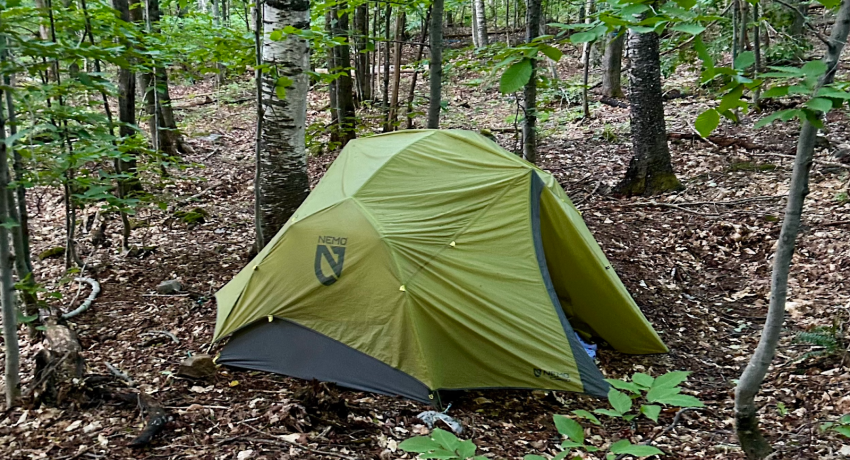This past summer and early fall I spent 4 months working on a backcountry trail crew in Western Maine on Tumbledown Mountain. I had never really slept in a tent before, so the prospect of finding the right one was a little daunting, and the vast amount of options and information was overwhelming. But I knew I had to do as much research as possible. It was, after all, where I’d be sleeping for the next 4 months of my life.
While researching which tent to buy, I came across the NEMO Dagger. It was out of my price range at $530 dollars, but had rave reviews. I resigned myself to buying a cheaper tent, but while at REI I found one in the used section for half the price! Unfortunately it was missing its landing zone (the storage “tub” that goes in the vestibule), but I wasn’t about to look a gift horse in the mouth.
In my 4 months on Tumbledown, we worked in sweltering heat, frigid cold, torrential rain, and high winds. Some days, heavy downpours would persist for more than 12 hours (Maine had a particularly wet summer last year). My gear and I stayed dry. There were many nights when the wind was so strong that multiple trees were down the next morning. My Dagger held up through it all while providing a spacious and comfortable place for me to sleep and store all my gear.
My Dagger did what a tent should do. It provided a safe, dry, and warm place to retire to at the end of a long and grueling day on the trail. If a tent can do that, and hold up through it all, it’s a good tent. But let’s break it down even further.
NEMO Dagger Osmo 2P Tent
Price: $530
Packaged weight: 4 lbs. 2 oz.
Packed size: 6.5 x 19.5 inches
Floor area: 31.3 sq. ft.
What we liked: Impressive durability for a light-weight tent.
Rating: 4.7/5
Table of Contents
Weight and Packability
Having never backpacked with a tent before, I can’t speak about how well this tent packs and carries versus others. But I can share my experience with this particular tent.
At 4lbs 2oz, there are certainly lighter tents. The Osmo 2p model added 4 oz. on from the previous version of the tent. There’s a saying I learned while on my first backpacking trip with Outward Bound: “Ounces equal pounds, and pounds equal pain”. This encourages slicing every unnecessary ounce off your pack. For backpackers hiking long distances every day it’s key to have something ultra light, but the only hiking we did with full packs was to make 3-4 trips a month up and down the mountain to set up and break down our camp during our 9 day hitches.
I initially struggled with packing my tent efficiently. I always separated my poles from the tent, which I stored in my pack’s side pocket. I started the season meticulously rolling up my tent and rainfly into the stuff sack and then storing the stakes and footprint on top (note: footprint is sold separately from tent). When storing the tent this way, I couldn’t fit it in my pack and had to store it on the outside. This proved unnecessary, time consuming, and actually less space efficient once I realized I could just stuff everything down into the sack and likewise stuff the stake bag and footprint into the side of the sack, alongside the tent and rainfly. I would then compress everything down into the stuff sack and roll the roll-top down as far as it could go and buckle it, effectively compressing the contents as small as possible.
When it comes to storing a tent there are two types of people: the rollers, and the stuffers. I’m now staunchly team stuff, at least when it comes to this tent. I never worried about ripping the material because it’s super durable, even when stuffing my stakes into the sack. When storing the tent this way, I found that I could fit it inside my pack, freeing up more room on the outside for larger items.
Overall, although not a “featherweight” tent, it packs and carries well and weight really isn’t much of a burden, considering how well it performs.

Setup and takedown
The Dagger Osmo can be set up in a pinch, which I did often because it rained a lot and I needed to get my gear somewhere dry fast. It’s as simple as setting down the footprint and tent, connecting their corners and staking them out, pressing the ball end of the poles into the four sockets to create the structure and then attaching the tent canopy to the poles using the clips. Then throw the rainfly on top, connect it to the structure using the color-coded clips and stake out the vestibules. It comes with a slight learning curve but probably took 5 minutes overall for me to set up. Taking it down is just as easy, just do everything in reverse!
Space and Livability
I chose a two person tent as I needed a place to store my gear for the 9 days that I was on each hitch, to protect it from the elements. A one person tent may make more sense for a solo backpacker who isn’t staying in one place often.
For my purposes, this 2 person tent performed beautifully, giving me ample room to sleep, change, and have all my stuff stored. My full length sleeping pad fit with room to spare, and while sitting up, my head didn’t come close to hitting the top. Keep in mind, I’m a 5’6” 120 lb. woman. With almost vertical sidewalls and over 20 square feet of floor area, I’m certain two people could fit and sleep comfortably in this tent while storing their gear in the roomy vestibules of the Dagger
Durability
In an effort to keep tents as light and spacious as possible, many manufacturers sacrifice durability. Nemo seems to strike a balance with the Dagger Osmo, offering moderately thin but super durable fabrics that are tear and abrasion resistant. The tent is made with Nemo’s own OSMO™ polyester-nylon fabric, which promises “4x better water repellency, 3x less stretch when wet, and a 20% higher strength rating than similar fabrics.” It’s also free of fire retardants and is woven from 100% recycled yarns to reduce waste. Yay for environmental sustainability!
While I did try to ensure that my tent was on a smooth and flat surface, there were unavoidable roots and rocks – but I never once experienced a tear or scuff on the tent. Keep in mind, I did use the footprint.
Protection from the elements
The sturdiness of the tent, combined with its impressive water repellency and tall bathtub floor ensured that I was protected from torrential downpours and high winds. This was not a rare event. It rained during every single hitch. And these were not just passing showers – it was often torrential and for hours, accompanied by blustering winds.
I slept safe and sound through possibly the worst storm of the season, and was only woken up once in the wee hours of the morning when my team leader Kolya came to warn me that we might need to hike down in the middle of the night because it was so dangerous. With each powerful gust of wind I braced myself, but the poles of the tent flexed and bowed to each one without coming loose or snapping. I was able to fall back to sleep soundly, knowing my tent would hold strong. Through it all, I never once experienced leaking or excessive stretching of the tent fabric. Even as the rainfly arcs upward on the sides, revealing a section of single-wall fabric, it’s truly waterproof and durable. Additionally, the included landing-zone that sits in the vestibule serves as a waterproof place to store gear.
Ventilation
In the warmer months I was still comfortable and never overheated given the generous amount of mesh and double-wall build of the tent. Unfortunately, humidity and dampness is unavoidable during summer on the east coast and the clothes I hung in my tent generally stayed damp for every rainy or humid day. But I never had to deal with condensation or dew in the morning. That being said, the Dagger offers a slightly different ventilation system than other tents. While other tents generally have deployable vents at the roof or sides, done by propping open the rainfly with some mechanism, the Dagger allows the user to unzip a portion of the top of each vestibule door, allowing deployability from inside the tent. I guess the satisfaction of this system is really up to personal preference. Though I liked being able to control the ventilation from the inside of the tent.
Storage
The Dagger Osmo has two doors and two vestibules, allowing two backpackers to comfortably get in and out of the tent with ease. The trapezoidal vestibules themselves are massive, allowing easy storage of boots and even a pack and other gear. The inside of the tent includes two lower mesh pockets, one upper mesh pocket at each end, and two nightlight pockets at either end that can be used for diffusing light from your headlamp. I had no issue finding room to stash my stuff, including my phone, wallet, pocket knife, clothes, and more.
Summary of NEMO's Dagger Osmo 2p Tent
Overall, my tent performed wonderfully throughout my season in Maine, and I feel that it was worth the price I paid ($280). It’s reasonably light and easy to pack, spacious, easy to set up, durable, and water-repellent. If the full price point of $530 is too much (which it was for me!), I’m certain that there are other tents that will do the same job but with fewer added bonuses.






